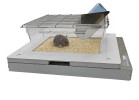Authors
Hart PC, Bergner CL, Smolinsky AN, Dufour BD, Egan RJ, Laporte JL, Kalueff AV.
Lab
Department of Physiology, Georgetown University Medical School, Washington, DC, USA
Journal
Methods Mol Biol.
Abstract
Animal models have been vital to recent advances in experimental neuroscience, including the modeling of common human brain disorders such as anxiety, depression, and schizophrenia. As mice express robust anxiety-like behaviors when exposed to stressors (e.g., novelty, bright light, or social confrontation), these phenotypes have clear utility in testing the effects of psychotropic drugs. Of specific interest is the extent to which mouse models can be used for the screening of new anxiolytic drugs and verification of their possible applications in humans. To address this problem, the present chapter will review different experimental models of mouse anxiety and discuss their utility for testing anxiolytic and anxiogenic drugs. Detailed protocols will be provided for these paradigms, and possible confounds will be addressed accordingly.
BIOSEB Instruments Used:
Activmeter (BIO-ACTIV-R)

 Pain - Thermal Allodynia / Hyperalgesia
Pain - Thermal Allodynia / Hyperalgesia Pain - Spontaneous Pain - Postural Deficit
Pain - Spontaneous Pain - Postural Deficit Pain - Mechanical Allodynia / Hyperalgesia
Pain - Mechanical Allodynia / Hyperalgesia Learning/Memory - Attention - Addiction
Learning/Memory - Attention - Addiction Physiology & Respiratory Research
Physiology & Respiratory Research
 Pain
Pain Central Nervous System (CNS)
Central Nervous System (CNS) Neurodegeneration
Neurodegeneration Sensory system
Sensory system Motor control
Motor control Mood Disorders
Mood Disorders Other disorders
Other disorders Muscular system
Muscular system Joints
Joints Metabolism
Metabolism Cross-disciplinary subjects
Cross-disciplinary subjects Preclinical studies and opioids: role in crisis management in the United States
Preclinical studies and opioids: role in crisis management in the United States 